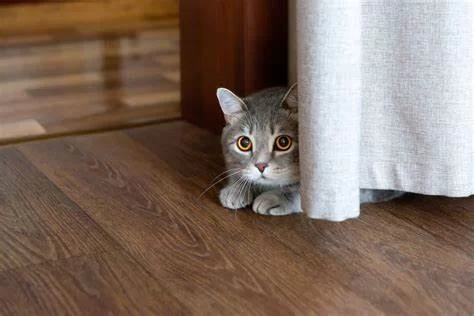Understanding Why Your Cat Hides All the Time
When I first brought home my cat, Muffin, I quickly noticed a strange behavior that started to worry me—she was hiding. At first, I thought she just needed time to adjust to her new environment, but as the days went by, she continued to retreat to dark corners of the house and avoid interaction. I had heard that some cats are naturally shy or independent, but this behavior seemed more intense than what I expected from a typical cat. It wasn't just occasional hiding; it was persistent and concerning.
After doing some research and speaking with my vet, I learned that cats often hide for a variety of reasons. Understanding the underlying cause of Muffin's behavior became the first step in figuring out how to help her feel comfortable and stop hiding all the time. Cats are masters at hiding discomfort, and sometimes what seems like a quirky behavior could be a sign of stress, illness, or anxiety. In this article, I'll share some of the insights I gained and offer practical tips on how to help your cat stop hiding so much, based on my experience and expert advice.
Common Reasons Why Cats Hide
Hiding is actually a natural instinct for cats, and it serves as a survival mechanism. However, if your cat is hiding too much, it’s important to consider the various factors that could be influencing this behavior. For Muffin, the main issue turned out to be a combination of anxiety and overstimulation. She had recently been rehomed, and the new environment, combined with a noisy neighborhood, created a sense of insecurity. I soon learned that other factors could include illness, changes in routine, or even environmental stressors.
Here are some common reasons why your cat might be hiding:
- Stress and Anxiety: Cats are sensitive creatures, and changes in their environment, such as moving to a new home, the arrival of a new pet, or even loud noises, can cause stress. Muffin, for instance, started hiding after we moved into a new apartment. It was a quiet area, but the occasional sounds of the city and new smells made her anxious.
- Illness or Injury: When a cat is feeling unwell or in pain, they often seek a quiet, dark place to rest. If your cat's hiding is accompanied by changes in appetite, litter box behavior, or grooming habits, it could be a sign of illness or discomfort. In Muffin’s case, her behavior was eventually linked to a minor gastrointestinal issue that resolved with a change in diet.
- Fear or Overstimulation: Some cats hide when they’re overwhelmed. Too much interaction, particularly from young children or unfamiliar people, can lead to hiding as a form of retreat. Muffin was quite nervous around strangers, and she would often hide when visitors came over. Gradually, I learned how to help her feel more secure in those situations.
1. Create a Safe, Quiet Space for Your Cat
The first thing I did to help Muffin feel more comfortable was create a designated safe space for her. Cats need to feel that they have a refuge, especially if they’re feeling stressed or unwell. I set up a cozy corner with her bed, a few of her favorite toys, and a blanket that smelled like me to provide her with a sense of security.
How to Create a Safe Space for Your Cat
Choose a quiet, low-traffic area in your home where your cat can retreat when they feel the need to hide. Make sure this space is away from the hustle and bustle of daily activities but still within your reach. For Muffin, I placed her safe space in a quiet bedroom away from the noise of the kitchen and living room. You can also add a cat tree or a scratching post nearby to provide stimulation and comfort.
Additionally, consider providing vertical spaces like shelves or high perches for your cat to observe their surroundings from a safe distance. Cats often feel more secure when they have an elevated vantage point to keep an eye on everything happening below. Over time, Muffin began to associate this space with calmness and comfort, which helped reduce her tendency to hide in other parts of the house.
2. Gradually Increase Social Interaction
Once I established a safe space for Muffin, I knew I had to work on building her confidence. Initially, she was hesitant to come out of her hiding spots, even for meals. So, I started spending quiet time with her, sitting near her safe space and allowing her to approach me when she felt comfortable. I didn't force any interaction; instead, I let her take the lead.
How to Encourage Social Interaction
The key to encouraging interaction is patience. I learned that forcing Muffin to engage on my terms only made her more anxious. Instead, I would place treats or toys just outside her safe space to encourage her to come out. Over time, she started associating my presence with positive experiences, which made her more likely to come out and interact with me on her own.
For shy cats, it can also help to establish a consistent routine. Cats are creatures of habit, and knowing when to expect meals, playtime, or attention can provide a sense of stability. Muffin responded well to a regular feeding schedule and began to trust that good things would happen when she ventured out of hiding.
3. Address Health Concerns
If your cat’s hiding behavior is accompanied by other signs of illness, such as lethargy, loss of appetite, or changes in litter box habits, it’s important to consult a veterinarian. Cats often hide when they’re not feeling well, and it’s their way of retreating to rest and heal. In Muffin’s case, I initially thought her hiding was simply anxiety from the move, but when I noticed changes in her eating habits, I took her to the vet.
How to Identify Health Issues
Health problems like dental disease, gastrointestinal issues, or urinary tract infections can cause your cat to hide. Pay attention to any signs of discomfort or changes in behavior. If your cat is also exhibiting symptoms like vomiting, diarrhea, excessive grooming, or avoiding the litter box, a vet visit is necessary to rule out medical issues.
Once Muffin’s stomach issues were addressed with a dietary change, her hiding behavior greatly improved. This reinforced the importance of always keeping an eye on any subtle signs of illness and addressing them quickly.
4. Provide Mental and Physical Stimulation
Another factor that can cause cats to hide is boredom. Cats, especially active and intelligent breeds, need mental and physical stimulation to prevent them from becoming stressed or withdrawn. I began incorporating more playtime into Muffin’s routine, offering her interactive toys like feather wands and puzzle feeders that engaged her mind and body.
Stimulating Your Cat’s Mind and Body
Regular play sessions are vital for preventing boredom. Interactive play, where you actively engage with your cat using toys, helps them burn off excess energy and keeps them engaged with their environment. Puzzle feeders, which require your cat to work for their food, are also great tools for stimulating their problem-solving skills.
Additionally, providing scratching posts, climbing trees, or even simple cardboard boxes can help your cat stay active and mentally stimulated. Muffin loved to explore different climbing structures and hide in boxes, which kept her entertained and less focused on hiding due to stress.
5. Be Patient and Consistent
Helping your cat feel comfortable and stop hiding all the time takes time. Patience is crucial during this process. I realized that forcing Muffin out of hiding or pushing her to interact before she was ready would only worsen her anxiety. Gradually, I made sure to provide her with the space, time, and consistency she needed to feel secure.
Consistency is Key
It’s important to remain consistent in your approach. Over time, Muffin came to trust that the world around her was safe. Regular, gentle interaction and a predictable routine allowed her to feel secure in her environment. As she began to trust me more and feel less anxious, her hiding behavior became less frequent.
Conclusion: Helping Your Cat Feel Secure
In the end, the key to helping your cat stop hiding all the time is understanding the underlying causes of their behavior and being patient as you work with them. Whether it's stress, anxiety, illness, or boredom, identifying the root cause of your cat’s hiding is essential for addressing it effectively. By providing a safe, quiet space, gradually increasing social interaction, addressing health concerns, and offering mental and physical stimulation, you can help your cat feel more comfortable and confident in their environment.
Remember, every cat is different, and some may take longer to adjust than others. With time, consistency, and love, your cat will learn to feel secure and stop hiding so much. If you continue to notice signs of distress, it’s always a good idea to consult with your vet to rule out any health issues. Ultimately, the more comfortable and secure you can make your cat feel, the more likely they are to come out of hiding and enjoy their life by your side.












